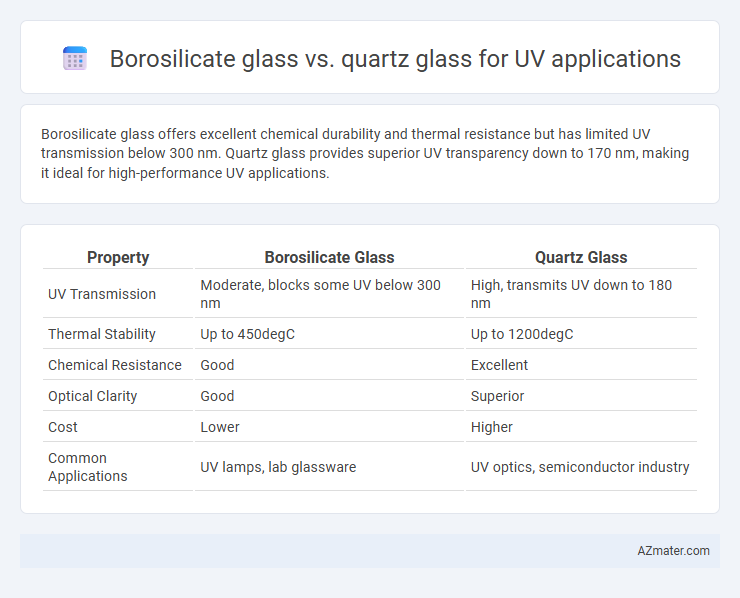Borosilicate glass offers excellent chemical durability and thermal resistance but has limited UV transmission below 300 nm. Quartz glass provides superior UV transparency down to 170 nm, making it ideal for high-performance UV applications.
Table of Comparison
| Property | Borosilicate Glass | Quartz Glass |
|---|---|---|
| UV Transmission | Moderate, blocks some UV below 300 nm | High, transmits UV down to 180 nm |
| Thermal Stability | Up to 450degC | Up to 1200degC |
| Chemical Resistance | Good | Excellent |
| Optical Clarity | Good | Superior |
| Cost | Lower | Higher |
| Common Applications | UV lamps, lab glassware | UV optics, semiconductor industry |
Introduction to UV Applications: Importance of Glass Selection
Borosilicate glass and quartz glass are critical materials for UV applications due to their differing transmission properties and thermal stability. Quartz glass exhibits superior UV transparency, particularly in the deep UV range (below 300 nm), making it ideal for high-intensity UV lamps, spectroscopy, and photolithography. Borosilicate glass, while offering good chemical resistance and thermal shock resistance, has limited UV transmission below 300 nm, restricting its use in applications demanding high UV clarity.
What is Borosilicate Glass? Key Properties
Borosilicate glass is a type of glass composed primarily of silica and boron trioxide, known for its exceptional thermal resistance and low thermal expansion coefficient (approximately 3.3 x 10-6 /degC). It exhibits high chemical durability and transparency to UV light in wavelengths above 300 nm, making it suitable for various UV applications. Compared to quartz glass, borosilicate glass has lower UV transmission below 300 nm but offers superior mechanical strength and cost-effectiveness for general laboratory and industrial use.
What is Quartz Glass? Key Properties
Quartz glass is a high-purity silica-based material known for exceptional UV transparency and thermal stability, making it ideal for UV applications. It features a low coefficient of thermal expansion, high chemical resistance, and excellent optical clarity across a broad UV spectrum, outperforming borosilicate glass in UV transmission. Its high melting point and durability under UV radiation ensure superior performance in demanding environments such as semiconductor manufacturing and advanced photonics.
UV Transmission: Borosilicate vs Quartz Glass
Quartz glass exhibits superior UV transmission compared to borosilicate glass, allowing wavelengths as low as 160 nm to pass through, making it ideal for deep UV applications. Borosilicate glass typically transmits UV light above 300 nm, limiting its use in applications requiring short-wavelength UV exposure. The high purity and low absorption of quartz glass enable efficient UV light passage, enhancing performance in photolithography, UV spectroscopy, and sterilization processes.
Chemical and Thermal Resistance Comparison
Borosilicate glass offers good chemical resistance against acids and alkalis but has lower resistance to hydrofluoric acid compared to quartz glass, which exhibits exceptional chemical durability even in aggressive environments. Thermal resistance of quartz glass surpasses borosilicate, with quartz glass handling temperatures up to 1200degC without deformation, while borosilicate glass withstands continuous use up to approximately 500degC. For UV applications requiring high thermal stability and superior chemical inertness, quartz glass is the preferred material due to its minimal thermal expansion and greater purity.
Durability and Lifespan in UV Environments
Borosilicate glass offers moderate durability and decent lifespan in UV environments, with resistance to thermal shock but limited UV transmittance compared to quartz glass. Quartz glass exhibits superior UV transparency and exceptional durability, maintaining structural integrity and optical clarity over prolonged UV exposure, making it ideal for demanding UV applications. The enhanced lifespan of quartz glass in UV settings is attributed to its high purity and resistance to UV-induced degradation, outperforming borosilicate in long-term performance.
Cost Analysis: Borosilicate vs Quartz Glass
Borosilicate glass offers a lower upfront cost compared to quartz glass, making it a budget-friendly option for many UV applications. Quartz glass, while more expensive due to its superior purity and UV transmission efficiency, provides longer lifespan and enhanced performance under intense UV exposure. Evaluating total cost of ownership, quartz may be more economical over time in high-demand environments despite its initial higher price.
Typical UV Application Scenarios for Each Glass Type
Borosilicate glass is commonly used in UV sterilization lamps and low-pressure mercury vapor lamps due to its excellent thermal resistance and moderate UV transmission, primarily in the UVA and UVB ranges. Quartz glass is preferred for high-intensity UV applications such as excimer lasers, UV curing systems, and deep UV spectroscopy because of its superior UV transmittance down to 190 nm and high thermal stability. In semiconductor manufacturing and UV photolithography, quartz glass's ability to transmit a broader UV spectrum makes it the ideal choice over borosilicate glass.
Pros and Cons: Borosilicate Glass for UV
Borosilicate glass offers excellent thermal resistance and affordability, making it suitable for many UV applications where moderate UV transmission is acceptable. Its lower UV transmittance compared to quartz glass limits performance in deep UV or high-intensity UV environments but provides better mechanical strength and chemical durability. Borosilicate glass is ideal for applications requiring robustness and cost-efficiency without the need for maximum UV transparency.
Pros and Cons: Quartz Glass for UV
Quartz glass offers superior UV transmission, especially in the deep UV range below 200 nm, making it ideal for high-precision UV applications such as lithography and spectroscopy. Its thermal resistance and low thermal expansion provide durability under intense UV exposure, but its higher cost and brittleness compared to borosilicate glass can limit its use in certain industrial environments. Quartz glass's purity minimizes absorption and fluorescence, ensuring maximum signal clarity in critical analytical and photonics applications.

Infographic: Borosilicate glass vs Quartz glass for UV application
 azmater.com
azmater.com